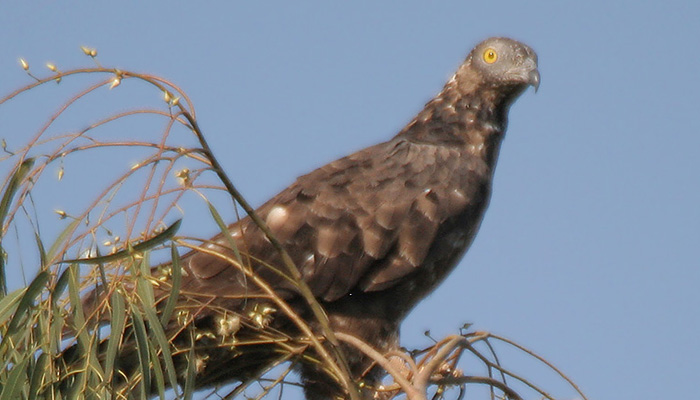
English: Oriental
Honey Buzzard, Crested
Honey Buzzard, Asiatic Honey-buzzard
Russian: Хохлатый осоед
German: Schopfwespenbussard
French: Bondree
orientale
Mongolian: Согсоот Гоорбис, Согсоот зөгийч сар
Japanese: ハチクマ (Hachikuma)
Body Length: 55-65
cm
Wing span: 130-155 cm
Habitat:
Breeds in the taiga of SC and E Siberia, often near bogs, rivers or clearings,
wintering in tropical Asia, from Arabia in the west (scarce!) to SE Asia. Near-annual
occurrence of odd migrants in Eilat, S Israel. Food mainly larvae and nests of
wasps, as in European Honey Buzzard. Nests high up in tree.
Identification:
Slightly larger and more eagle-like and broader-winged than European Honey Buzzard,
with ‘fuller’ wing-tips (6th primary longer, constituting one more ‘finger’);
the broad wings make had look small and give the bird a rather ‘heavy’
impression in flight. As its name implies, has elongated crown-feathers forming
small crest, but this is rarely erected or seen. Recognition first alerted by
size and shape, then confirmed by plumage characters.
- Adult
♂: Readily told by characteristic tail pattern with only two and very broad and
prominent dark bands, one at tip, the other near base (♂ of European Honey
Buzzard has two narrow bands basally apart from broad terminal one). Adult ♀:
Unlike ♂, much more similar to ♀ European Honey Buzzard, with two similar
narrower basal bands on tail, but possible to separate on: lack of dark carpal
patches; more bars on secondaries (3-4 inside terminal bar rather than 2) which
are more evenly spread, lacking wide step between terminal and penultimate typical
of European Honey Buzzard; narrow and poorly marked darker trailing edge to wing
compared to that of European Honey Buzzard; barring of primaries denser and
more irregular (‘messy’) than in European Honey Buzzard; often an obvious dark
brown or black marking on side of throat and across lower throat.
- Juvenile:
Variable in plumage, mostly very similar to corresponding morphs of juvenile
European Honey Buzzard, only invariably lacks dark carpal patches (whereas
Honey Buzzard only exceptionally lacks carpal patches). Generally noticed due
to large size and broad wings making head look particularly small, after which identification is confirmed by absence of
carpal patches, details in wing shape, plumage etc. Usually, secondaries are
less dark than in European Honey Buzzard and therefore show more obvious dense
barring (usually 5-6 bars visible as against commonly 4 in European Honey
Buzzard)